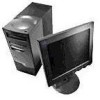IBM 6868 User Guide - Page 17
Audio subsystem, Integrated Ethernet adapter, System management features, Input/output features
 |
UPC - 087944494911
View all IBM 6868 manuals
Add to My Manuals
Save this manual to your list of manuals |
Page 17 highlights
Audio subsystem Integrated audio controller compatible with Microsoft® Windows® Sound System Supports most Sound Blaster applications Integrated Ethernet adapter: Support for Wake on LAN® Support for Alert on LAN™ System management features Remote Program Load (RPL) and Dynamic Host Configuration Protocol (DHCP) Wake on LAN (requires Wake on LAN-supported network adapter) Wake on Alarm Remote Administration (ability to update the power-on self-test (POST) and the basic input/output system (BIOS) over the network) Automatic power-on startup System Management (SM) BIOS and software Ability to store POST hardware test results Built-in system-management hardware (temperature sensors, fan-speed monitor, chassis-intrusion detector, power supply and microprocessor voltage monitor, and power-switch bypass) Input/output features 25-pin, Extended Capabilities Port (ECP)/Extended Parallel Port (EPP) One 9-pin, 16550 universal asynchronous receiver/transmitter serial port Two 4-pin, Universal Serial Bus (USB) ports Mouse port Keyboard port Monitor port (on the AGP adapter) Three audio connectors (line out/headphone out, line in, and microphone) Expansion capability Four available drive bays. Four or five available PCI expansion slots (depending on model) with support for 32-bit PCI Plug and Play adapters. Support for additional internal and external SCSI devices (the number of internal devices that can be installed is limited by the number of available drive bays, power, and cooling requirements). Support for additional IDE or EIDE devices. Chapter 1. IBM IntelliStation overview 3















